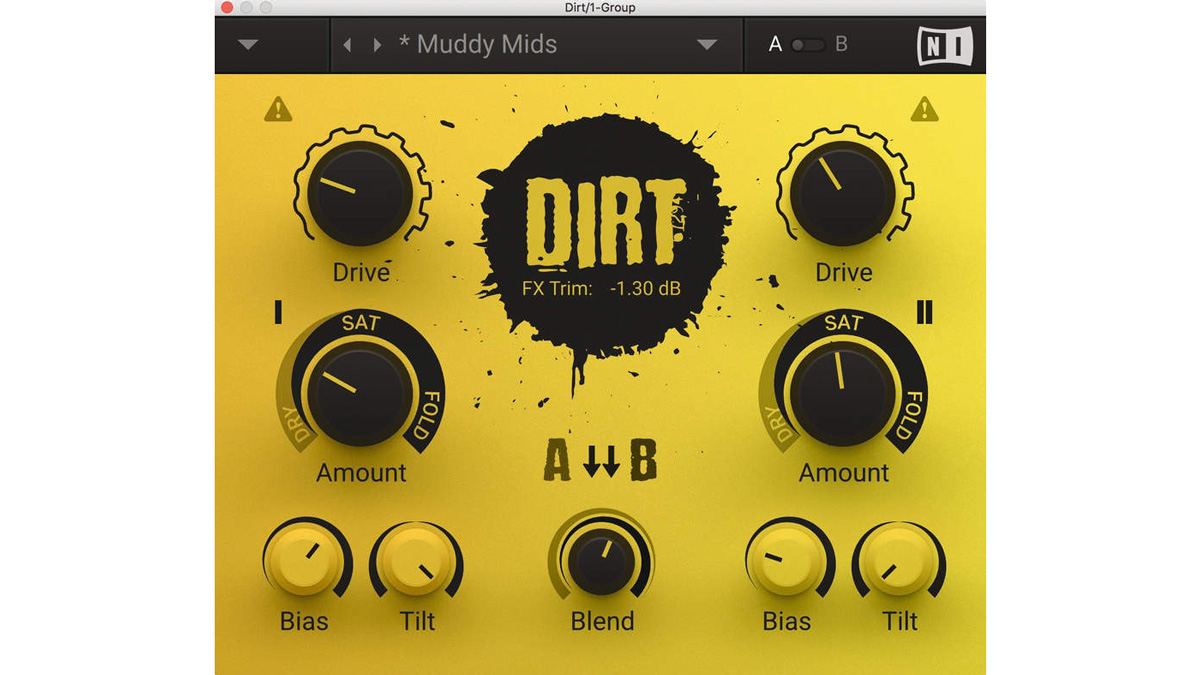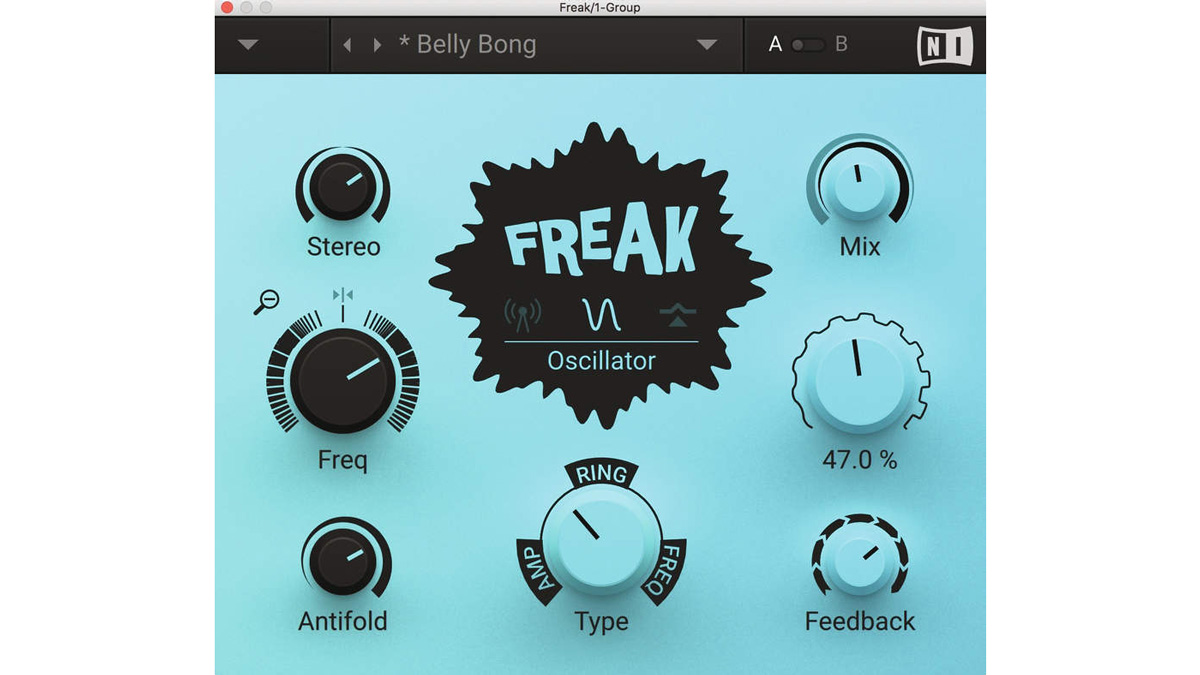MusicRadar Verdict
Another must-have creative signal- processing pack from the German giant, at a ridiculously low price. Don’t miss it!
Pros
- +
Delicious clipping, digital and AM-based distortion .
- +
Freak’s Radio mode is so sick.
- +
We love NI’s groovy new UI style.
- +
What a bargain!
Cons
- -
Dirt and Bite would be even better with a little modulation.
MusicRadar's got your back
Adhering to the stylistic template set by its excellent Mod Pack, NI’s Crush Pack comprises three circuit-modelled distortion plugins (VST/AU/AAX), designed with musicality and immediacy at the top of the agenda. Let’s dive straight in...
Dig the Dirt
The most ‘general purpose’ distortion in the Pack, Dirt is a stompbox-style effect modelling a pair of diode clipping stages: A and B. These can be routed in series in either direction (A to B, or B to A), or parallel, whereupon the dry/wet Mix knob becomes a Blend control, mixing the A/B outputs to taste.
Each stage has its own input Drive control, with output gain compensation active by default but defeatable if required, and can be set to one of three increasingly heavy distortion modes. The Amount control dials in saturation for the first half of its travel, then begins to fold the waveform back on itself for the second half, dramatically increasing crunch; and the Bias and Tilt knobs work in harmonics- boosting asymmetry and see-saw equalisation (high cut/low boost or low cut/high boost).

Dirt’s polychromatic dual-stage architecture and earthy analogue sound make it particularly well suited to warming up or brutalising bass and guitar, gluing drum busses and heating up vocals. It’s also fiendishly effective on synths and drum machines, delivering everything from presence-enhancing bite at low levels to screaming serration when pushed into the wavefolding range.
Bite the dust
Bite serves up digital distortion to emulate the ever-in-vogue sound of vintage hardware samplers by the likes of Akai, E-MU et al. What that means in practical terms is bit depth and sample rate reduction, the first accessible on the left-hand side of the interface, the second on the right. The big, self-explanatory kHz and Bits spinners roll down from 44.1kHz and 16-bit to 100Hz and 2-bit, but there’s more to this filthy device than just that, of course.
The Jitter parameter randomly fluctuates the sample rate around the specified value independently for the left and right channels, not only messing up the signal quite delightfully but also widening it. The Pre and Post low-pass filters do away with aliasing by sitting at the Nyquist frequency (half the sample rate) at their centre detents, but can also introduce it for creative purposes when twisted clockwise.
As well as Oscillator mode, Freak also features a Sidechain input mode for modulation via the input or an external signal, and the unique Radio mode, emulating the sound of an AM radio.
In Sidechain mode, the directly analysed modulation signal can be blended with the output of an envelope follower, for a highly shapeable response, with a band-pass filter on call for narrowing the modulation frequency range. It brings a useful dynamic control aspect to Freak, and also makes us wonder why the other two plugins weren’t similarly equipped, for modulation of saturation amount, sample rate, etc.
In Radio mode, two Demodulation circuit types emulate an envelope detector and a product detector, the latter being the more spectacularly ‘resonant’ of the two. The Carrier knob sets the demodulation carrier frequency (increase for higher fidelity), and ‘dialling in’ the radio is done using the Tuning knob, with interference increasing to either side of the centre point. The demod circuit band-pass filter is also adjustable, for balancing resonance and noise.
Radio mode is tricky to get a handle on, but the evocative retro and extra-terrestrial ‘broadcast’ sounds it makes are absolutely awesome.
Over on the right, the DC function prevents bit depth quantisation to zero, smoothing (for want of a better word!) the sound out to some extent; and Crunch attenuates the input level, thus reducing the quantisation range, for continuous resolution changes without stepping. Dither and Expand, meanwhile, add stereo noise and adjust the bias of quantisation resolution towards low-level signals, ultimately turning them into square waves for a less detailed, ‘nastier’ sound.
Want all the hottest music and gear news, reviews, deals, features and more, direct to your inbox? Sign up here.
Lastly, the Saturation knob applies gain-compensated analogue-style distortion; the HP filter cuts the output off at 5, 100 or 200Hz for low-end control; and the dry/wet Mix knob enables parallel processing, which this fantastic sound design tool would be far less practical without. Again, it’s the scope and versatility of Bite that sets it apart from other, similar plugins: whether you just want to infuse a beat with a touch of old-school hip-hop flavour or shoot for full-on chiptune digitalia, it walks the spectrum.
Get freaky
Modelling a diode ring circuit, Freak offers three fundamental modes of operation - Oscillator, Radio and Sidechain (the last two are discussed in Radio star) - each one changing the functions of the three contextual knobs on the left. For all modes, the Type knob morphs the modulation style smoothly from Amplitude through Ring to Frequency shifting.
Amplitude modulation involves wobbling of the volume level, for tremolo effects at low frequencies and the generation of audible ‘metallic’ sidebands at high frequencies. Ring modulation is similar, but replaces the input with sidebands rather than adding them to it. Frequency shifting is rather different, offsetting the frequency content of the input signal in linear fashion - a bit like pitchshifting in that it makes the whole sound go ‘higher’ and ‘lower’, but far more destructive, colourful and creative, as the relative spacing of frequencies isn’t maintained.
In Oscillator mode, modulation for the Amp and Ring Types is controlled by a sine wave running at up to 5kHz (positive or negative), the speed determining the frequencies of the sidebands. With the Frequency shifter Type, Freq sets the amount by which the input signal is shifted in Hz/kHz. For an increase in perceived stereo width, the bipolar Stereo knob dials in phase offset between the modulation of the left and right channels; while the Antifold knob thins out the distortion by preventing sidebands from folding over at 0Hz.
Common to all three modes, the Feedback and Harmonics knobs route the output back into the input, and add even harmonics. Feedback is particularly useful for emphasising phasing treatments, creating the ‘barber pole effect’ with low-speed frequency shifting, and various other kinds of transformations.
A rich source of inharmonic noises, sci-fi burbles, detuned sweeps, crazy frequency wanderings and so much more, for us, Freak is the jewel in the Crush Pack crown. That’s not to say that its stablemates are in any way ‘lesser’, though - all three of these stellar sound- mangling plugins sound wicked.
Dirt and Bite would benefit from the addition of an envelope follower or two, but at this price, we really can’t complain, to be honest. Go get ’em now.
Computer Music magazine is the world’s best selling publication dedicated solely to making great music with your Mac or PC computer. Each issue it brings its lucky readers the best in cutting-edge tutorials, need-to-know, expert software reviews and even all the tools you actually need to make great music today, courtesy of our legendary CM Plugin Suite.

